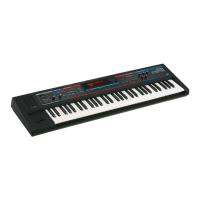64
Detailed Settings for Performance Functions
3.
Use the dial to set the desired value.
* The target affected by the function assigned by “Type” will depend on the settings of JUNO-Di.
If you’re playing a single sound, the effect will apply to the currently selected sound.
If you’re playing multiple sounds (i.e., when the [PERFORM] button is lit), the effect will apply as follows.
• In Dual or Super Layer mode: all parts
• In Split, or otherwise: the currently selected part
4.
Press the [EXIT] button to leave the edit screen.
SOLO SYNTH
Item Value Description
Level
0–127 Sets the volume of the Solo Synth.
Range
2OCT, 4OCT, 8OCT
Sets the Solo Synth to a pitch range of 2 octaves, 4 octaves, or 8 octaves.
EXPRESSION
Item Value Description
Range Min
0–127
Lower limit of the range of the Expression.
The effect will be applied when the position of your hand above the D Beam
controller is lower than this value.
Range Max
0–127
Upper limit of the range of the Expression.
The effect will be applied when the position of your hand above the D Beam
controller is above this value.
* By setting “Range Max” below “Range Min” you can invert the range of change.
ASSIGNABLE
Item Value Description
Type
MODULATION,
PORTA-TIME,
VOLUME,
PAN,
PORTAMENTO,
SOSTENUTO,
RESONANCE,
RELEASE-TIME,
ATTACK-TIME,
CUTOFF,
DECAY-TIME,
VIB-RATE,
VIB-DEPTH,
VIB-DELAY,
CHORUS-SEND,
REVERB-SEND,
AFTERTOUCH,
BEND-UP,
BEND-DOWN,
START/STOP
The D Beam controller can control the following functions.
The number in parentheses ( ) is the controller number of the control change message produced by the D Beam controller
when the corresponding function is assigned.
* The target of the following functions will depend on the current settings. For details, refer to the note that follows the table.
MODULATION (CC01):
Vibrato
PORTA-TIME (CC05):
Portamento time (p. 59)
VOLUME (CC07):
Level
PAN (CC10):
Pan (left/right position of the tone)
PORTAMENTO (CC65):
Portamento switch (p. 59)
SOSTENUTO (CC66):
The sound will be sustained only for keys that were already pressed.
RESONANCE (CC71):
Resonance (p. 66)
RELEASE-TIME (CC72):
Release time (p. 65)
ATTACK-TIME (CC73):
Attack time (p. 65)
CUTOFF (CC74):
Cutoff (p. 66)
DECAY-TIME (CC75):
Decay time (p. 65)
VIB-RATE (CC76):
Vibrato speed
VIB-DEPTH (CC77):
Vibrato depth
VIB-DELAY (CC78):
Vibrato delay time
CHORUS-SEND (CC93):
The amount of the chorus
REVERB-SEND (CC91):
The amount of the reverb
AFTERTOUCH:
Channel aftertouch
BEND-UP:
The pitch will rise when you bring your hand closer to the D Beam controller. The amount of available pitch
change is determined by the value set for “Bend Range Up” (p. 59).
BEND-DOWN:
The pitch will fall when you bring your hand closer to the D Beam controller.The amount of available pitch
change is determined by the value set for “Bend Range Down” (p. 59).
START/STOP:
By moving your hand over the D Beam you can start/stop the Song Player (p. 72) or Rhythm Pattern (p. 74).
Range Min
0–127
Lower limit of the range of the D Beam controller.
The effect will be applied when the position of your hand above the D Beam controller is lower than this value.
Range Max
0–127
Upper limit of the range of the D Beam controller.
The effect will be applied when the position of your hand above the D Beam controller is above this value.
* By setting “Range Max” below “Range Min” you can invert the range of change.
Range Min
Range Max
JUNO-Di_e.book 64 ページ 2009年6月22日 月曜日 午前9時23分

